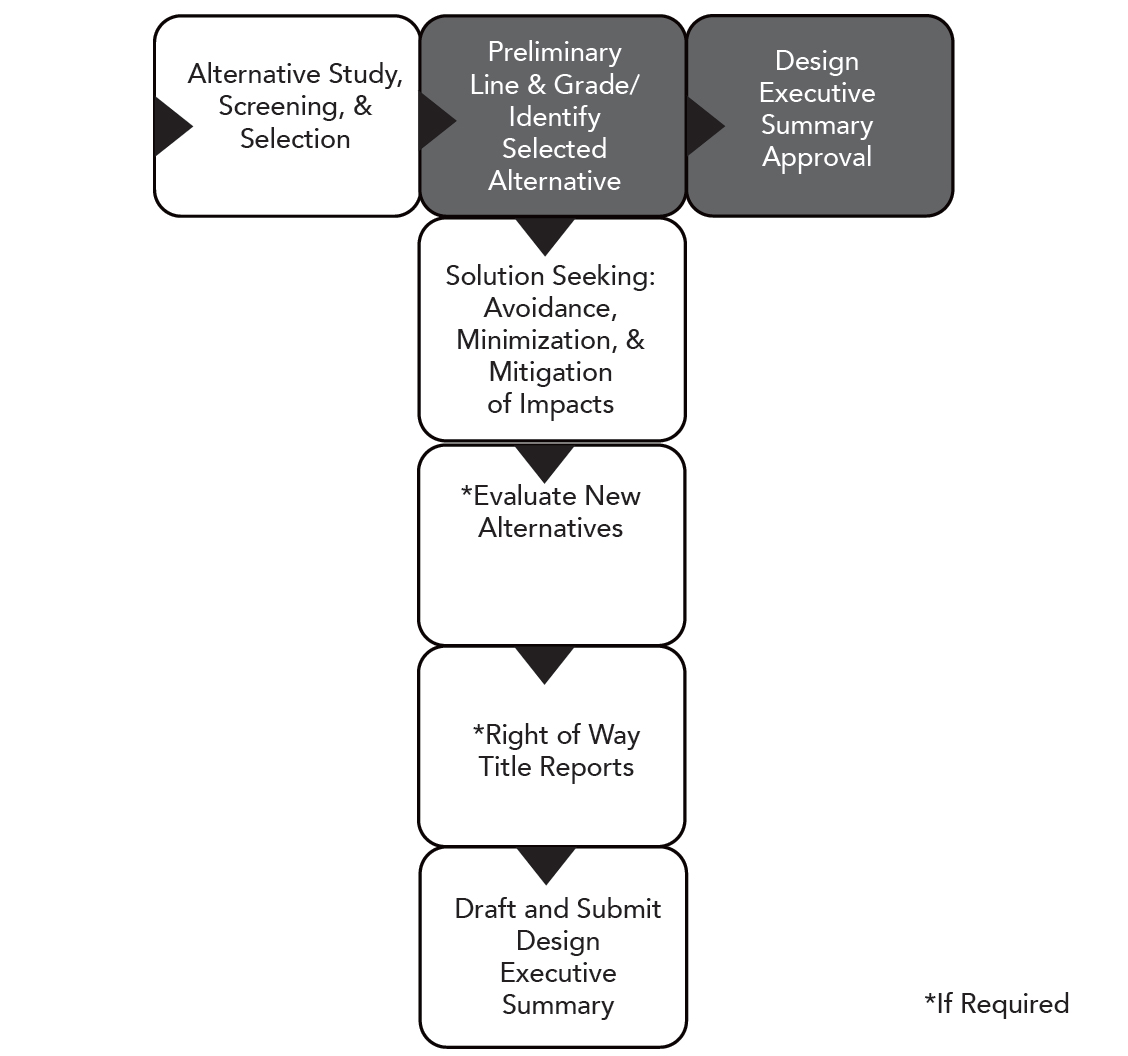Search for articles or browse our knowledge portal by topic.
Identify Selected Alternative

Contents
1. Preliminary Line and Grade/Identify Selected Alternative/
Solution Seeking: Avoidance, Minimization & Mitigation Of Impacts
2. Evaluate New Alternatives (If Required)
3. Right of Way Title Reports (If Required)
4. Draft and Submit Design Executive Summary and Design Executive Summary Approval
Milestone
After SMEs have studied the project’s range of alternatives, the PDT should meet to select a preferred alternative. An assessment of the social, economic, and environmental impacts of a proposed action or project informs the PDT’s deliberations and helps members identify their preferred alternative. Also, opinions voiced at late-stage public meetings are important considerations when selecting an alternative.
At the Preliminary Line and Grade (PL&G) Meeting PDT members discuss reasonable alternatives for the proposed project. The primary goal of the PL&G Meeting is to select a preferred alternative and document the rationale for the decision. SMEs present results of their investigations to the DEC, who, in turn, presents to the PDT. For example, environmental SMEs will describe how each alternative will impact the study area’s environment. For each alternative, SMEs will discuss impacts, summarize impact mitigation, and provide a time frame for resolving issues which have been identified. PDT members with construction expertise will assist with evaluating temporary traffic control and construction phasing for each alternative. During these assessments, the PDT discusses requisite diversions, including their construction and ROW cost estimates. Construction experts judge whether the proposed ROW is sufficient based on issues such as equipment access, construction phasing, and Manual on Uniform Traffic Control Devices (MUTCD) requirements. ROW and Utility agents should also present their findings during this meeting so the PDT may fully consider the possible impacts of property acquisition and utility location on the transportation decision.
When determining a preferred alternative, the PDT must work through the decision-making process for highway projects. This includes avoidance, minimization, mitigation, and possibly enhancement of each alternative’s impacts. Decisions are recorded in NEPA documentation and the DES. Guidance for creating these documents is found in the Environmental Analysis Guidance Manual and the Highway Design Guidance Manual, respectively.
The PM and PDT use available data, analysis, and professional judgment to select the preferred alternative.
Red Flag
During the PL&G meeting, the project team considers and discusses for each alternative potential strategies to maintain traffic operations during construction. This discussion will be summarized in the PL&G minutes. For some alternatives, problems related to the maintenance of traffic and constructability may be insurmountable. It is critical to examine these issues when developing alternatives.
PL&G meeting minutes are a critical part of the Design Executive summary and serve as the main body of the DES. These minutes should document most, if not all, of the design decisions prior to moving into final design. For more information, see the Highway Design Guidance Manual (HD-203.5).
PL&G meeting attendees should be granted at least two weeks to examine review materials. Schedule the distribution of review materials accordingly.
On Federal-aid projects whose environmental document is an Environmental Assessment/ Finding of No Significant Impact (EA/FONSI) or an Environmental Impact Statement (EIS), following the approval of the environmental assessment and public hearing, the PDT should meet to select a preferred alternative based on environmental, economic, and engineering issues, anticipated performance, and public input. The final environmental document should then be prepared, reviewed, and approved. The output should be the final approved environmental document and the alternative selected to proceed into final design.
It is possible — especially on more complex projects — for new alternatives to surface late, even as the end of Phase 1 seems imminent. If the new alternative(s) looks promising (e.g., achieves the Purpose and Need at a lower cost or with fewer impacts), the PM and PDT may determine that additional information and time are required to investigate it. Consideration must be given to the project budget, schedule, and milestones when deciding to examine new alternatives late in Phase 1. However, a newly discovered alternative that reduces impacts may simplify and compress the Phase 2 schedule, affording time for study while still meeting the targeted letting goal. The PM and PDT should discuss and determine whether the new alternative merits further examination. If looking at the new alternative will require more design funding or time, the decision should be coordinated with the CDE and Central Office for their approval.
When KYTC acquires ROW for a project, the historical chain of property title is documented and submitted on a title report. This search looks at historical property ownership. The source of each title is obtained by contacting property owners and searching the county clerk’s records. ROW acquisition and supporting activities normally occur during Phase 2. However, it may be advantageous to start title report work at the end of Phase 1. Other ROW activities that can begin at the end of Phase 1 include starting development of the ROW project report and compiling relocation worksheet data. When ROW plans have been developed to a stage that it is possible to identify encroachments on the existing ROW, ROW title reports may be gathered. If the PM and ROW supervisor believe ROW title reports may be difficult to complete, securing title reports as a preliminary ROW activity may save time later in Phase 2. Directions for requesting title reports is provided in the Right of Way Guidance Manual (ROW-403-2).
If the duration of project development prevents ROW from being completed in a timely manner, title reports created during Phase 1 may require updates. Work done on title reports created as a preliminary ROW activity is nonetheless valuable since the historical information documented is valid and only recent property ownership (covering the time frame since the title report was completed) needs to be examined.
Side Note
Red Flag
Property may not be acquired under preliminary ROW activities. Acquisitions do not begin until authorized by the Director of the Division of Right of Way, Utilities, and Rail.
Milestone
At the end of Phase 1 — typically after the PL&G Meeting and identification of the selected alternative — a DES is drafted and submitted to the Division of Highway Design. PL&G meeting minutes serve as the main body of the DES. The DES is the record of engineering decisions related to the project. It contains the rationale used to justify the preferred alternative and requested design exceptions or variances. Projects administered by the Division of Highway Design require a DES unless the Division Director grants an exemption. The Division of Highway Design uses this information to document the decision-making process, including preferred alternative selection and design exceptions or variances. The Division of Environmental Analysis uses the DES to identify required environmental actions.
Since the DES outlines the rationale used to make design decisions, it is important for the DES to contain all pertinent information used in the decision process. Information on DES contents, approval processes, and examples may be found in the Highway Design Guidance Manual (HD-203.6). DES forms are available on the Division of Highway Design Intranet webpage.
Red Flag
The DES approval process is tiered so that more complex projects require review and approvals. For example, final DES approval on the most complex projects requires signatures from the Location Engineer, Roadway Design Branch Manager, and Director of the Division of Highway Design. As project complexity increases, the time required for DES review and approval increases as well.
On FHWA oversight projects (Projects of Divisional Interest [PODIs] and Projects of Corporate Interest [POCIs]), the DES must be provided to FHWA, and their approval for design exceptions must be solicited separately from Division of Highway Design approvals. FHWA approval of design exceptions are included in the project record.
After the DES has been submitted and approved, in some instances design decisions are re-evaluated and changes made. When this occurs, the DES must be amended. See HD Section 203.6.2 for procedures for amending the approved DES.
Time Management for Highway Project Development Knowledge Book:
Access the complete Knowledge Book here: Time Managment Knowledge Book
Next Article: Environmental Approval
Previous Article: Alternative Study, Screening and Selection


